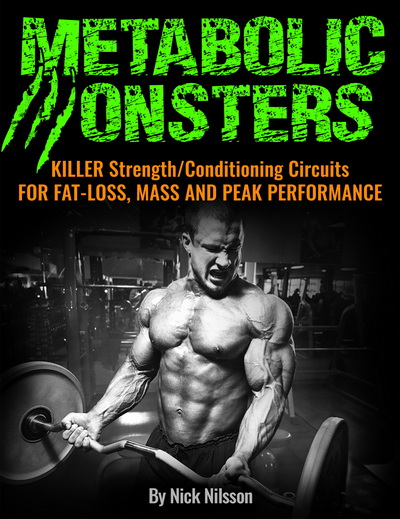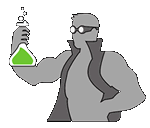We'll be using three bodyweight exercises in a shortened range of motion to maximize lactate production (a.k.a. Lactic Acid), which in turn body ramps up GH secretion, which is a KEY hormone for burning fat
It's also important for maintaining muscle mass while on a reduced-calorie diet.
The shortened range of motion allows for several things...
1. You can get more reps at a given resistance (for the first exercise especially)
2. You have the ability to use a bodyweight exercise variation that supplies more resistance (particularly for the first and second exercises)
3. No full relaxation of the muscles results in blood flow occlusion that prevents/delays removal of lactate (and other waste products) from the local muscles being worked. This build-up of waste products is (ironically enough) actually an excellent muscle growth stimulus.
The three exercises we're going to use for this will cover all the major muscle groups in your entire body...most particularly back, chest and thighs, but also including all the other smaller parts as well as secondary movers.
You'll be doing all three of these exercises IN THE ORDER that I list...this is an important point. I have them in this order for a reason.
And you'll take NO rest in between each exercise. Literally go as fast you can from one to the next. These are bodyweight exercises so there's no equipment to play around with.
GH Exercise #1 - Top-Range 1/4 Chin-Ups or Inverted Rows
For the first exercise, you're going to do just the top 4 to 5 inches of the range of motion of a chin-up or inverted row. Approximately the top 1/4 of the exercise. This is going to strongly target your back and biceps (and abdominals as stabilizers).


Do these as FAST as you can WITHOUT bouncing. There will be a certain amount of momentum because of the tempo and plenty of elastic rebound happening within the muscles, but the idea is not to bounce but to maintain tension in the muscles as you CRANK out reps as quickly as you can.
Get as many reps as you can...I think I got 60+ on this set.
If you're not ready for chin-up partials, go with Inverted Row partials (the lower the bar, the more bodyweight resistance you'll have for the movement). Follow the same idea of short range of motion at the top, fast reps, keeping muscle tension on.
We're starting with a back exercise first in order to be able to use the most resistance, so that we can generate a lot of lactate. This is because of the sheer amount of muscle mass affected by chins or inverted rows (more so than Exercise #2).
GH Exercise #2 - Middle-Range 3/5 Push-Ups
For push-ups, we're going to target the middle part of the range of motion. The top range won't give us enough muscle tension, even though it's got better leverage.
So basically, go down until your chest is a few inches above the ground and come up short of lockout, keeping your elbows bent.


Again, do these FAST, but not so fast that you pop up too high and your arms straighten. We want to keep the tension on the chest, triceps and shoulders so that we develop as much lactate as possible and KEEP it there.
If you can't do these in the full push-up position for at least 20 to 30+ reps, I would recommend elevating your hands on a bench or on a bar that's a few feet off the ground rather than doing kneeling push-ups. Part of the benefit of the push-up is that it's essentially a dynamic plank, so you would be missing out on some good core work by kneeling.
We're doing push-ups second because the resistance is less. Fatigue would be more of a factor for the back exercise if we tried to do push-ups first, then chins.
As well, by working your back first, you actually create a "neuromuscular antagonist" situation. In English, this means that by working the opposing muscles first, you'll actually be a bit STRONGER when you go to do the push-ups. And this means you'll get more reps and generate more lactate.
GH Exercise #3 - Bottom 1/2 Bodyweight Squats
The final exercise is the "easiest" of the three...the bodyweight squat. And that "easisness" is the reason it's last in this sequence. You've generated a TON of lactate with chins and push-ups...and it's all still floating around in your body. There hasn't been time to clear it and there's no buffer left.
THAT is when we immediately start working the biggest muscles in your body...
And we'll do it staying in the bottom half of the range of motion.


The reason for staying in the bottom half is muscle tension...if we come up higher, the leverage gets MUCH better and the exercise becomes TOO easy. We also lose the constant tension on the quads and glutes.
Perform reps holding onto something solid with your right hand, then as your arm fatigues (and it will, especially after the other stuff you just did), switch hands.


Keep going until your legs basically don't function anymore. And I mean that literally...because for maximum lactate production, you want to keep going until you get to the point where you're still TRYING to push, but nothing is happening.

And don't worry...you won't get super sore from this because we're targeting CHEMICAL failure here, not muscle fiber failure. What this means is that the pH (acidity) shuts down muscle function without creating a lot of muscle fiber damage.
You're Done With Your GH Fat-Loss Finisher!
All you need is one round through all three of exercises and that's your finisher. You'll be done in about 2 to 3 minutes, depending on how many reps you get and each exercise and/or how determined you are to push to your limit.
You will have generated a TON of lactate and your body will have no choice but to crank up GH production.
This would be an excellent to perform after the 3 Exercise 1 Dumbbell Countdown workout.
---
And if you like this workout, you'll LOVE these ones...
- The Single Dumbbell Attack
- Total-Body Countdown Murder
- The Inside Out Core Crusher
- Lactate Tolerance Training for Chest
- Dueling Banjo Hell
- The Good Morning Burger
Share This Page...
Want More Training and Nutrition for Fat Loss?
You'll find it here...



